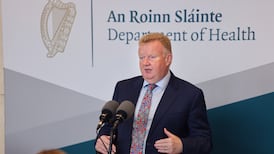The death, during or very soon after the birth, of a healthy full-term baby to a healthy woman who has experienced an uncomplicated pregnancy is, thankfully, a rare occurrence in Ireland today. But an audit of perinatal deaths shows it does happen in maternity hospitals around the State.
The Perinatal Mortality in Ireland Annual Report 2012 includes a special section on perinatal deaths associated with intrapartum events – those that occur during childbirth or delivery – to raise awareness of the occurrence of unexpected stillbirths and early neonatal deaths of normal birthweight babies who are full term or near full term.
These unexpected deaths are devastating for the parents involved and traumatic for the medical staff. There were 11 such deaths in 2011 and 13 in 2012, reflecting a rate of one in 6,084 births in Ireland. While the 13 deaths in 2012 accounted for just 2.9 per cent of the 445 perinatal deaths in Ireland that year, the authors of the report point out that these cases accounted for one in eight of the 106 cases of perinatal death with normal birthweight and gestation of at least 37 weeks.
In January of this year, RTÉ's Prime Time "Fatal Failures" programme revealed that baby Mark Molloy, who died 22 minutes after his birth at the Midlands Regional Hospital in Portlaoise on January 24th, 2012, was alive at birth and had no congenital abnormalities.
Mark and Róisín Molloy's battle for the truth about the circumstances surrounding their baby's death led to the Prime Time programme and ultimately to an investigation by the Health Information and Quality Authority (Hiqa) into the safety, quality and standards of maternity service at Portlaoise.
Prime Time revealed that Mark Molloy was one of four babies who were alive at birth and had no congenital abnormalities but died at the hospital in Portlaoise between 2006 and 2012, either during labour or shortly after birth after suffering a fall in oxygen. The chief medical officer, Dr Tony Holohan, published a report this year which found the maternity unit at Portlaoise was unsafe.
Not enough oxygen
The
Perinatal Annual Report
, which is compiled by the
National Perinatal Epidemiological Centre
(NPEC) at University College Cork, shows that a high proportion of the deaths of the normal birthweight babies near or at full term in 2012 were associated with hypoxic ischaemic encephalopathy, a condition in which the brain does not receive enough oxygen, and had no associated obstetric factors.
The gestation at delivery was at least 37 weeks for all 24 babies and the deaths occurred in 11 of the 20 maternity units in the country in 2011 and 2012. While the numbers were too small to draw conclusions, the authors noted no maternity unit had a significantly higher rate than any other.
The authors recommended a retrospective in-depth review of a series of unexpected perinatal deaths during childbirth and delivery to provide additional information about quality of care.
Dr Paul Corcoran, a senior lecturer at the NPEC and one of the authors of the report, told The Irish Times: "These cases are rare but they do happen across the country and the only way to really understand what is happening is to do an in-depth review of the medical records of a series of cases in different hospitals going back over a number of years rather than simply reviewing isolated, individual cases and moving on.
“This is the only way we will learn how to prevent these devastating events and make improvements in services.”
In-depth clinical audit
The Perinatal Mortality in Ireland Annual Report 2012
is the second report from this in-depth clinical audit.
Reporting to the NPEC is not a statutory requirement but all 20 Irish maternity units voluntarily provided anonymised data relating to perinatal deaths that occurred in 2012.
Perinatal mortality refers to the death of babies in the weeks before or after birth, including stillbirths, and is an important indicator of the quality of obstetric and neonatal care.
This year’s report also makes a specific recommendation on the need to adhere to the national clinical guidelines on fetal growth restriction (FGR), published by the HSE in August, to standardise and improve antenatal detection and care and the timeliness of delivery in order to reduce perinatal morbidity and mortality.
Low birthweight was prevalent among perinatal deaths in 2012: 54 per cent of stillbirths and 40 per cent of babies who died within seven days were below the normal range of birthweight. The report points out that one of the core problems in FGR is the poor detection rate in pregnancies that are at risk of adverse outcome, in particular stillbirth. Current antenatal detection rates of FGR are reported to be as low as 25-36 per cent.
“One of the biggest areas where we can reduce our perinatal death rates is through identifying and managing fetal growth restriction,” says Dr Corcoran.
“As the report for 2012 shows, so many of the babies who died were below their optimal growth rate.
“We need better antenatal monitoring to reduce rates, which means more scanning, and where there is a growth issue detected, we need to balance bringing delivery dates forward against intervening too early.”
The 304 stillbirths accounted for more than 60 per cent of the 485 perinatal deaths recorded in 2012, while the 141 deaths within the first seven days of life accounted for nearly 30 per cent of deaths.
Despite the fact that advances in obstetrical and critical neonatal care are reflected in a substantial decrease in the overall perinatal mortality rate in high-income countries such as Ireland, stillbirth rates have remained largely unchanged over the past years, affecting one in 200 pregnancies.
This audit found an association between perinatal death and multiple pregnancies. There were 47 perinatal deaths from multiple births, making up 10.5 per cent of all perinatal deaths in 2012.
Consequently, the perinatal mortality rate of 18.6 per 1,000 multiple births was three times the national rate.
Core findings: Perinatal deaths 2011-12
A total of 485 perinatal deaths in 2012 were recorded, arising from 71,755 births of at least 24 weeks' gestation or at least 500g birthweight.
Stillbirths, early neonatal deaths (within the first seven days of life) and late neonatal deaths (within the first eight to 28 days of life) accounted for 304 (62.7 per cent), 141 (29.1 per cent) and 40 (8.2 per cent) of the 485 deaths respectively.
The perinatal mortality rate was 6.2 per 1,000 births. The stillbirth rate was 4.2 per 1,000 births and the early neonatal death rate was 2.0 per 1,000 births. These rates are almost identical to the equivalent rates reported for 2011. However, Irish perinatal mortality rates have decreased by about 10 per cent in the five years for which the NPEC has reported national figures and they compare favourably with UK and European rates.
Major congenital anomaly was the most common cause of death, accounting for 26 per cent of stillbirths, 48 per cent of babies who died within seven days and 38 per cent of babies who died within eight and 28 days.
After major congenital anomaly, respiratory disorders were the other main cause of early (31 per cent ) and late (23 per cent) neonatal deaths.
About 70 per cent of the deaths arose from pre-term births, ie births before 37 weeks' gestation.
Low birthweight was highly prevalent: 54 per cent of stillbirths and 40 per cent of babies who died within seven days were below the normal range for birthweight.
11 per cent of the perinatal deaths arose from multiple birth deliveries. By contrast, multiple births accounted for just 4 per cent of all births in 2012.










